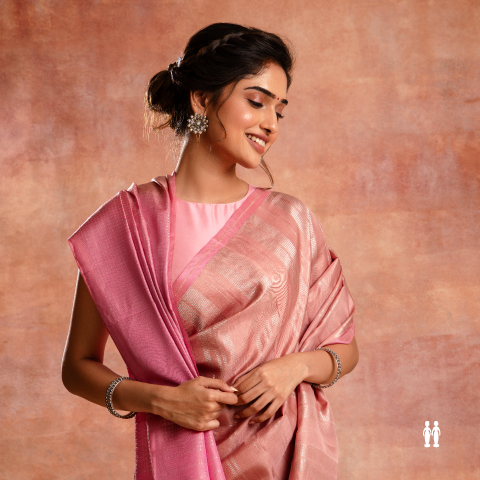The integration of South Indian art and culture can be clearly traced in the craftsmanship of our loom. The weavers were inspired by huge temples with religious significance and derived symbolic meanings from its architecture. One such striking design element which has an instant recall, when anyone speaks of Kanchipuram silk sarees, are the Gopuram motif borders.

The multi-storeyed masonry of a Gopuram, or the ceremonial entrance gateway, is a ubiquitous structure in a South Indian temple, introduced back in the 14th century. The gopurams of Meenakshi Amman temple in Madurai, the Ranganathaswamy temple in Srirangam and the Ekambareshwarar temple in Kanchipuram are representative of the highly evolved Dravidian temple architecture style. One is awestruck by the massiveness of proportion and the excellence of craftsmanship found in the towers, pillars and sculpture-laden walls when visiting these temple towns Tamil Nadu.

The Gopuram or temple borders have spire-like motifs linking the border and the body, and are referred to as "rekku".These spires gracefully interlock and blend into the body of the saree, tapering like temple gateways.
Just as we stand amazed at the superhuman skill of artisans who have built the dominating gateways of temples, we are mesmerized by this stunning visual design element in a traditional Kanchipuram saree.

Another design that links the body and border is a small triangular-shaped gopuram called as the "Pillayar Moggu", (Pillayar meaning Ganesha and Moggu meaning a conical shaped bud in Tamil).
The entire Kanchipuram saree is divided into three parts - Udal, Karai and Mundhanai. Udal represents the body, Karai represents the border and Mundhanai represents the pallu. Traditionally, the borders are woven with two types of designs, called "Pettu".
1. A rich solid border woven at both ends is called as Gettipettu. (Getti meaning thick). The Gettipettu is woven densely with a lot of motifs like Mayilkann (Peacock's eyes) or Kuyilkann (Koel's eyes), or a Bavanchi border with solid zari bands, usually with rich brocade patterns.

2. Sometimes, the border has spacing in between and has two edgings within the karai, and this design is called as "Rettai Pettu" or "Double Pettu".
A typical Gopuram form in a temple's architecture is the product of growth and evolution over centuries. The same pattern is juxtaposed along the border of a silk saree and is woven as a structural placement tapering upwards on the body of the saree and replicating the gateways.
The geometric precision of the Gopuram borders and Rekkus have become a part of the aesthetic ethos of a Kanchipuram silk saree. It has gained an identity of its own, absorbing and incorporating ideas from the beautiful temples of the South.






